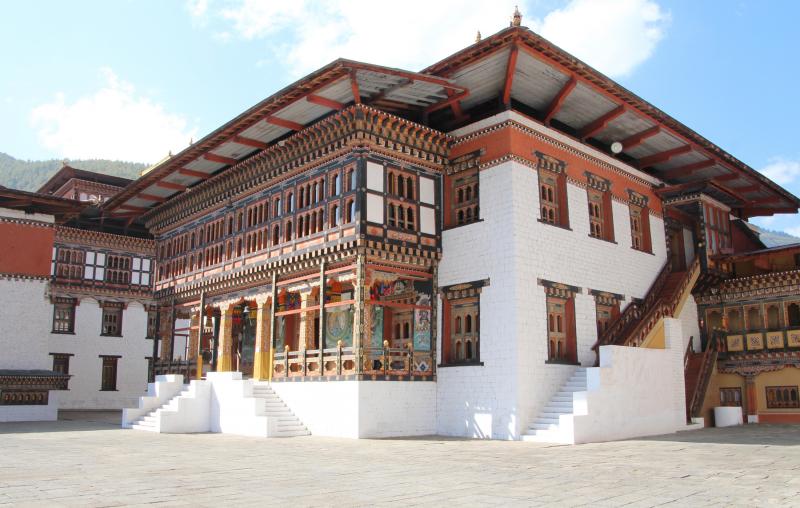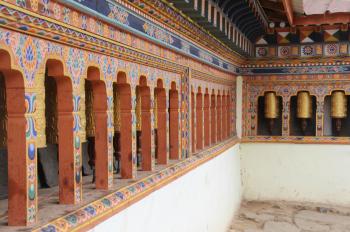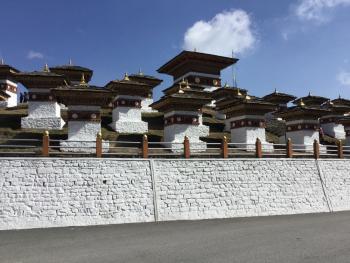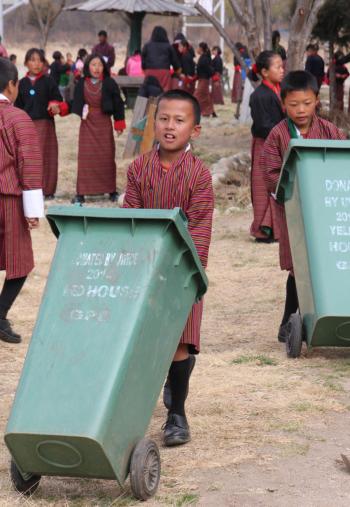Satisfying a decades-long curiosity with a visit to the remote kingdom of Bhutan
This article appears on page 18 of the October 2017 issue.
Approximately 30 years ago, I passed up an opportunity to spend a month or two in the remote, little-known Kingdom of Bhutan as a trainer in a management program. At that time, the government allowed very few tourists to enter this mysterious, protected, tiny kingdom. As Bhutan became more open and increasingly on the radar of travelers, I wondered what I had missed.
To satisfy my curiosity, in late February and early March 2017, my wife, Rosie, and I spent two weeks in Bhutan with 10 others on a Road Scholar tour ($3,592 per person plus airfare between Los Angeles and Kathmandu).
Choosing Bhatan
Bhutan is a predominantly Buddhist country, and a traveler cannot help but notice the omnipresent evidence of this faith — colorful prayer flags, stupas, temples, visual representations of Buddha and red-robed monks. That the secular government and Buddhist monks share the dzong (fortified building) in Thimphu reveals the importance of the country’s religious heritage.
Tsechus (Buddhist festivals), filled with masked and costumed dancers commemorating Buddha or military victories, serve as significant attractions for masses of local Bhutanese as well as numerous visitors.
Rosie and I enjoy learning about traditional cultures, including their textiles, arts, food, architecture, social customs, religion and system of governance, and we love meeting locals. Additionally, it helps if our chosen destination happens to be in the midst of beautiful and stunning scenery. In our reading about Bhutan, those expectations seemed likely to be met.
The members of our tour with Road Scholar (Boston, MA; 800/454-5768, roadscholar.org) met in Kathmandu and flew to Paro, where Bhutan’s main airport is patterned after the traditional architecture found throughout the country.
Our Bhutanese guide, Tshittim Jamtsho (Tim), and his associate, Kunzang Thinley (Kun), met us at the airport. They each wore a traditional men’s gho, which wraps around the body and hangs to the knees, similar to a kimono. Women wear kiras (long dresses) that are made of colorful cotton or silk with traditional designs. All persons working in government offices, schools and in tourism, as well as those attending formal occasions, are required to wear traditional dress.
Our itinerary covered six cities located in roughly two areas of the country: western Bhutan (Paro, Thimphu, Phobjikha Valley and Punakha) and central Bhutan (the Bumthang Valley and Trongsa). The distance between Paro and our easternmost destination (Jakar, in the Bumthang Valley) was 181 miles.
For much of the time, we drove on the main east-west national highway that stretches across the entire country, which was undergoing substantial rebuilding and widening. The longest distance we traveled in one day was 127 miles, primarily on narrow and often winding dirt roads, which took, including rest stops and lunch, eight hours! Fortunately, we rode in a comfortable van, safely navigated by our driver, who should have received numerous awards for his skill.
Thimphu
From the airport in Paro, we traveled through farmland along a river on a well-maintained, sometimes 4-lane, highway to Thimphu, Bhutan’s capital and largest city.
Compared to the other cities we visited, Thimphu was a bustling urban area, its main street filled with retail stores, restaurants and nightclubs catering to both locals and tourists. Here, down jackets, running shoes, blue jeans and cell phones compete with traditional dress.
As we drove to our hotel, we began to notice the ubiquity of the traditional architecture, with its white walls and typical hand-carved and hand-painted wooden features.
We stayed in the Namgay Heritage Hotel, reputed to be one of Thimphu’s finest hotels. Although it seemed like an older structure — dark, with faded furniture — its rooms were spacious, our bathroom was modern, and there was a small but functioning elevator.
Generally, we found the accommodations throughout our tour to be basic, with a few high-end hotels and restaurants. We stayed in very clean, modern and comfortable places, and each was distinctive and traditional — charming but not Hyatt-like. Unlike many tourist hotels, most appeared to be operated by families, not chains.
The food served was usually very well prepared, although there was not much variety in the almost-twice-daily servings of soup, rice, noodles, potatoes, fresh veggies and chicken chunks (with bones) or occasionally pork plus the national dish, ema datshi, extremely spicy chili peppers and cheese. That said, as a special treat, we did enjoy one lunch of delicious pizza.
During our first morning in Thimphu, we visited a center of Buddhist culture, walking to the National Memorial Chorten (a religious structure that is central to the culture) around which Buddhist adherents walk and pray. What I found interesting was that it tended to be older people who were circling the chorten and turning the prayer wheels or sitting in small clusters chatting quietly on the grass or on benches shaded by a tree, a wall or a makeshift lean-to.
We also visited the National Institute for Zorig Chusum, dedicated to teaching Bhutan’s 13 traditional types of art: painting, carving, sculpture, leatherwork, papermaking, blacksmithing, bamboo work, gold and silver smithing, embroidery, masonry, casting, carpentry and weaving.
The students, who appeared to be in their late teens and early 20s, may each spend up to six years at the institute learning their specialty. We had the opportunity to visit some of the classrooms and studios and chat with the students, finding them to be open and enthusiastic as they explained their work.
During our time in Thimphu, we also visited two other arts-and-crafts exhibits. The first was the National Textile Museum, a modern 2-story building containing traditional clothing, festival costumes and examples of various weaving styles. In an adjacent building, weavers demonstrated their skills on floor looms. The second site was a small shop that produced handmade paper. We followed the process, from the pouring of a white, sticky pulp, which is spread out to dry, to its being cut before becoming the final product.
As we returned to the hotel, our guide spotted an archery match, so we stopped and watched. As it is Bhutan’s national sport, it was not uncommon for us to see archery competitions taking place in nearly every area that we visited.
The Phobjikha Valley
Following three nights in Thimphu, it was time to continue east to our next destination, the Phobjikha Valley. Our drive, slowed by the fog and road conditions and including a stop for a tea break, covered 84 miles in slightly less than eight hours.
As we drove through the valley toward our hotel, we passed a pasture filled with a flock of 20 to 30 black-necked cranes, one of the major attractions in the area, their heads bent, foraging for tubers, insects and frogs. These endangered, gangling-legged birds that grow to 4 feet tall visit this protected area from November through February. Having religious and cultural significance for the Bhutanese, they are welcomed back with a fall festival in the local monastery.
Pine trees surrounded much of our hotel, Dewachen Lodge, which overlooked a small village and had a panoramic view of the valley. By the time we arrived in the late afternoon, the temperature had dropped dramatically to the low 30s and, thankfully, hot tea around a large, iron, wood-burning stove awaited us in the dining area.
Our tour of the Phobjikha Valley began with a visit to the Gangtey Goemba Monastery, originally built 400 years ago and most recently refurbished in 2008. As we passed through a gate into a large open plaza, we came upon the facade of the main central tower with its intricately painted carved wood.
The monastery includes five temples and houses 200 to 300 monks, many of them young boys, living in small, cell-like rooms. Following their education there, some of the students go on to a nearby Buddhist college.
During our visit, numerous families with children arrived, many of them in pickup trucks or wagons pulled by farm tractors. It seemed similar to a Sunday-morning church scene in a small American farming community, where families gathered together for a worship service as well as social time with friends and neighbors.
We then went on our first hike, apparently in preparation for a more strenuous one at the end of our journey. The 3-mile Gangtey Nature Trail descends from the village below the monastery to the floor of a glacial valley. The trail then ascends gently up along the sides of the valley, following a meandering river through farmland and a few villages and past a stupa with a water-powered prayer wheel.
Before we returned to the floor of the valley to board our van, we stopped at an overlook where our guides had set up a rest stop with our daily tea and cookies.
Bumthang
Next, we continued on to the Bumthang District, the easternmost part of our tour. The drive was another 8-hour journey, as we moved slowly because of thick fog and the frost on the road. The dirt road had become muddy and went along several sheer cliffs, but our driver had steady eyes and hands.
After crossing Pele La Pass (10,989 feet), we drove through countryside filled with rhododendrons and dwarf bamboo, passing huge, shaggy yaks roaming along the side of the road, then dropped to a lower elevation to reach Jakar, a small, commercial town. We stayed in Kaila Guest House, a family-run hotel whose 70(-plus)-year-old founder still visited the hotel daily to eat and chat up the other diners with an outgoing friendliness, humor and generosity.
Our first venture in Jakar took us to two of Bhutan’s oldest and most sacred monasteries. Jambay Lhakhang monastery was built in the 7th century, and Kurjey Lhakhang was built in the 17th century on a holy site dating back to the 8th century. Each of the monastery’s temples contained extraordinary interiors.
The path between the two monasteries wound through rice fields, vegetable gardens, willow trees and grazing land for cattle, dotted by farmhouses. As we approached the Kurjey temple, a forest of multicolored prayer flags fluttering gracefully from their tall poles welcomed us.
One of the most poignant experiences of our trip occurred when a fellow traveler placed the ashes of her deceased husband, who had hoped to visit Bhutan, in a nearby river while our guide, Tim, briefly spoke about Buddhist beliefs regarding death.
Trongsa
We began our western-bound trip along Highway 2 (the same as Highway 1 but with traffic going in the opposite direction), with Trongsa as our destination. Following a 3-hour drive from Bumthang, we descended into Trongsa, a town of approximately 19,000 residents with two major cultural attractions: the Ta Dzong (Watchtower) Museum and the Trongsa Dzong.
The 350-year-old watchtower building overlooks the town and its dzong, which it once protected. Recently renovated, the building contains 11 galleries on its five floors, exhibiting exquisite art and relics that represent Bhutan’s history and monarchy. In contrast, the museum’s on-site restaurant did not share such excellence.
Most travelers approach the Trongsa Dzong through a tunnel entrance that takes them up to its spacious courtyard, somewhat like entering a medieval castle. One side of the courtyard looks out over sheer cliffs at the town below, while a temple (closed to the public) and other buildings surround the other sides.
The day we visited, children and dogs were playing in the courtyard, with the occasional monk scurrying about. It happened that on that day, a rehearsal of a dance for an upcoming festival was taking place in the temple, and we were allowed to observe several monks wearing masks and colorful costumes whirling about.
We stayed at another excellent hotel, Yangkhil Resort, located on a hill above and a bit outside the city, which, fortunately, had an adequate heating system for the rooms.
Punakha
Our next destination, Punakha (4,400 feet), required another long drive, but it was well worth it.
While the main town in the district, Khuruthang, has little to offer tourists, the area is the location of the Punakha Dzong, possibly the most beautiful and important dzong in Bhutan, featuring traditional architecture and art.
Located at the confluence of two rivers (one can enter only through a covered wooden bridge over one of the rivers), it is a massive structure — a 6-story central building with three courtyards and the typical whitewashed walls, wooden beams and posts decorated with hand- painted designs in brilliant colors.
On the day of our visit, we were fortunate to discover that the Domchoe Festival, commemorating Bhutan’s defense against Tibetan invaders, was being held at the Punakha Dzong. Hundreds of local Bhutanese, young and old, dressed in traditional dress filled the main courtyard to watch the dancing.
High above the courtyard and sitting on a throne-like chair in a balcony draped with brightly colored banners, the Chief Abbot observed the festivities below. Men wearing masks and exotic, brightly colored costumes representing animals and warriors each whirled about in a near trance. A group of women, dressed in vibrant kiras and standing shoulder to shoulder, swayed from side to side while singing.
Contained in another, smaller courtyard were a temple, inaccessible to visitors, and, open to the public, a larger temple with huge statues of Buddha and, on its outer walls, paintings of the Wheel of Life.
Following a delicious picnic lunch, prepared by a caterer, we hiked to the Khamsum Yulley Namgyal Chorten across a flag-bedecked, pedestrian-only suspension bridge — which spanned a gently flowing river carrying visitors piled in inflatable rafts — and then through small family plots of rice and vegetable crops.
Because of a flare-up in my sciatica, I did not accompany the group all the way to the hilltop site. Instead, I sat comfortably in the shade of a pergola located halfway up the hill, overlooking the fields and their farmers, and chatted with other hikers as they passed by.
Our stay in Punakha, with the hikes to the temple and chorten along with seeing the stunning dzong and festival, remained one of the trip’s most memorable times for most of us.
Back to the beginning
On our return trip to Paro, the visibility improved substantially. When we reached the Dochula Pass, unlike on our previous fog-filled stop, the crisp, clear skies enabled us to see the dramatic, snow-covered Himalayan range that we had dreamed of as well as the terraced farmland below and the 108 stupas of the Druk Wangyal Chortens.
Moving on to Paro, the last destination on our itinerary, we went first to the National Museum, another renovated watchtower, which sat upon a hill overlooking the Paro Dzong. The museum housed a variety of objects, including antique textiles and masks, thangkas (paintings) and religious statues, plus information on natural history and the environment.
Khangkhu Resort, built on the side of a hill, served as our final hotel. The traditional buildings had spacious and well-appointed rooms with large windows that faced the valley. Its restaurant buffet was excellent.
Tiger’s Nest trek
The last day of the tour was the “biggie” for the hikers: an excursion to Taktshang Goemba, widely known as Tiger’s Nest Monastery, 3,000 feet above the Paro Valley floor. Our trek up to the monastery would start from the parking lot trailhead, about 1,700 feet below it, and take about three to six hours for the round trip (depending on breaks and speed of walking).
The monastery appears to cling to the side of a rock cliff, and I suspect its image is the most well-known photograph of Bhutan.
I decided to go slowly, walking with another tour member who also had some mobility problems, while Rosie stayed at the hotel. The trail initially went through a relatively flat, heavily wooded area of pine trees, but soon its incline began to steepen. (I remember thinking that it reminded me of my last stress test… only my stress tests never included pack horses galloping seemingly out of control, sometimes only a few feet away, returning from carrying passengers up to the top of the trail.)
Along the way, we came upon a few benches and rocks in the shade that allowed for rest breaks and served as spectacular viewing points.
At about the halfway mark, we arrived at a teahouse/café where visitors could order light snacks or a meal. My hiking mate and I decided to stop at this point and enjoy the view from a shaded bench on the patio while sipping coffee and tea and devouring energy bars.
We then returned to the trailhead and waited for our tour mates to return. Out of the nine hikers who went beyond the teahouse, three or four turned back before crossing over a valley to reach the monastery. The others returned later, tired but exhilarated that they had made it to the top and were able to experience the spectacular view.
Despite the group’s weariness, there were still shoppers among us whose needs had yet to be fully met, so we spent the final hour of our day checking out the various small stores in Paro.
Summing up
The next morning we returned to Kathmandu, where the group stayed at the Hyatt Regency until our respective flights to the US departed.
In reflecting on why we had gone to Bhutan, we’d have to say that, for the most part, our expectations were met. The tour exposed us to a traditional culture marked by beautiful textiles, art and architecture plus a devotion to religion and a respect for the land and the ecosystem.
It will be interesting to watch this kingdom wrestle with the issue of sustaining its unique culture while adopting the policies and tools of economic and technological development, including the likelihood of increased tourism.
We felt that the only downsides of this trip were the sameness of the food served and the occasional long van rides, about which we had been forewarned. Also, if we had traveled a month later, in late March and/or early April, the weather might have been milder and more flowers would have been in bloom.
As with many overseas group excursions, our interactions with Bhutanese citizens were somewhat limited to hotel staff, a few guest speakers, employees in tourist shops, a few people we met on the street and, of course, our guides, Tim and Kun.
Tim and Kun were the most exceptional guides we have encountered in the five or six tours we have taken. They were well educated, enthusiastic about their country, humorous, willing to share personal information and extremely helpful, and they spoke flawless English.
Anyone with questions may write to me at rsundeen@usc.edu.





